THE DIRECTORY OF AUSTRALIA SILVERSMITHS
|
|
|
created by Giorgio B. owner of www.silvercollection.it ©  |
| This is a page of A Small Collection of Antique Silver and Objects of vertu, a 1500 pages richly illustrated website offering all you need to know about antique silver, sterling silver, silverplate, sheffield plate, electroplate silver, silverware, flatware, tea services and tea complements, marks and hallmarks, silver marking system and silver hallmarks guide, articles, books, auction catalogs, famous silversmiths (Tiffany, Gorham, Jensen, Elkington, WMF, Reed & Barton, Mappin & Webb, Bateman Family), history, oddities ... SITE MAP - HOME PAGE |
| AUSTRALIA SILVERSMITHS ALPHABETICAL LISTING - S - T - U - V - |
| AUSTRALIAN SILVERSMITHS
A
B
C
D
E
F
G
H
I
J
K
L
M
N
O
P
Q
R
S
T
U
V
W
X
Y
Z
NOT IDENTIFIED ALPHABETICAL LISTING OF MARKS |
(click on the photo to enlarge image)
| SILVERSMITH'S NAME AND MARKS |
SILVERSMITH'S INFORMATION |
SANDERS W.J.

 |
New South Wales, Sydney William James Sanders (1885-1946) of English origin, emigrated to Australia in 1911 and opened his workshop at 80 Hunter Street, Sydney, in 1912. In 1915 he moved at 212 Clarence Street and in 1924 to 1 Lee Street, Railway Place where W. J. Sanders, manufacturing silversmiths, goldsmiths and art metal workers was located for close on half a century. The "Elephant's Head" figural mark (part of coat of arms of the Sanders family) was used by W. J. Sanders, W J. Sanders Pty Ltd and subsequently, AmorSanders Pty Ltd from c.1915 to 1996 |
SARGISON AROLD F.
 |
Hobart, Tasmania (125 Liverpool Street)
Arold F. Sargison (1885-1983) was active from 1920 c. to 1980, when he retired at the age of 95.The silversmith is known for his ecclesiastical wares, in particular the gold monstrance, designed by Alan C. Walker, made in 1932 for Hobart's St Mary's Cathedral. He is also the maker of the Tasmanian Mace for the House of Assembly Chamber. |
SCANDIA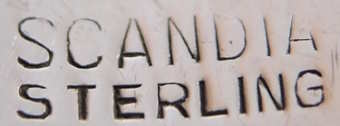 |
Victoria, Melbourne maker of hand made jewelry, active from 1963 |
SCHAFER Edward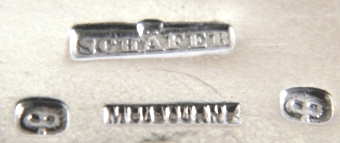 |
Victoria, Melbourne active circa 1880 |
SCHOMBERG Julius |
South Australia, Adelaide active 1850s/1860s |
SHEFFIELD MANUFACTURING & PLATING CO LTD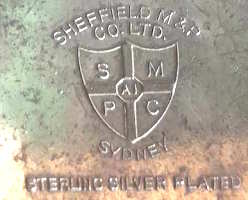 |
New South Wales, Sydney founded c. 1899, was an overseas arm of the well known Walker & Hall company from Sheffield, England. They were located at 309 Pitt St Sydney. Circa December 1916, they relocated to 84 Wentworth Ave Sydney to a new 5 story building, later known as "Sheffield House" where they operated until they were liquidated in June 1953. |
SILCRAFT PTY LTD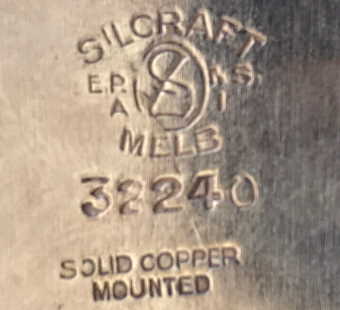
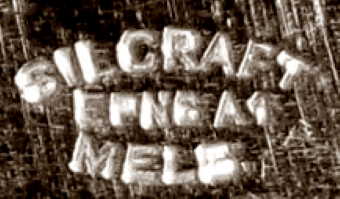 |
Victoria, Melbourne Founded in 1930 by J. and Mary I Sharp. Later, their Managing Director Mr A.F. Thompson and his family took over the company. They expanded during the late 1940s, with many new employees, later moving to 82 Dandenong Road Oakleigh in the early 1950s. They were then relocated not far from there at 168 Forster Road Mount Waverley. Silverware production ceased in late 1950s |
| SNOW BROS J.T. SNOW 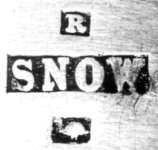
 |
Queensland, Brisbane active from 1864 (125 Queen Street). Became J.T. Snow (117 Queen Street) in 1899. Out of business c. 1901 |
STEETH J. W. & SON |
Victoria, Melbourne J.W. Steeth and Son was founded in the early twentieth century by James William Steeth (c.1884-1959) and continued by James' son Maurice James Francis Steeth (c.1913-1970). Fortunato Rocca, who joined the firm as apprentice in 1962, continued the family business after the death of Maurice Steeth until c. 2000. Steeth was active at Arco House, Melbourne using the mark 'J S & S in a trefoil' |
STEINER Henry












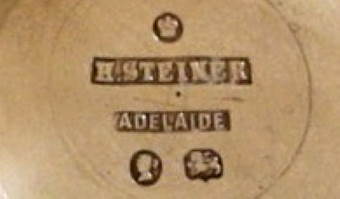

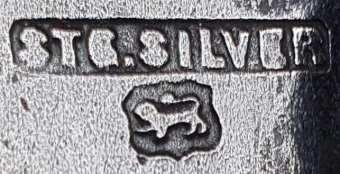 |
South Australia, Adelaide Henry Steiner was born in Rodenberg, near Hanover, Germany in 1835. He immigrated to Adelaide in 1858, and set up his business in 1860, on Rundle Street. In Adelaide his creations obtained great success enjoying the patronage of governors and other elites and showing his production in exhibitions across Australia and overseas (Paris Exhibition Universelle in 1878 and The Melbourne International Exhibition in 1880). In 1884, after the death of his wife, he sold off his business to August Brunkhorst and returned to Germany where died in 1914 |
STEVENSON Walter Hunter
 |
South Australia, Adelaide founded Stevenson Bros at 20 Rundle Street, Adelaide. The business was active in Adelaide from 1878 to 1956 |
| STOKES Thomas STOKES & SON STOKES & SONS STOKES (Australasia) Ltd. 
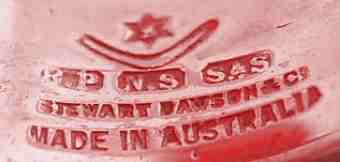
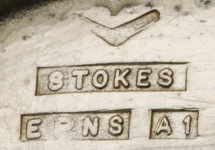
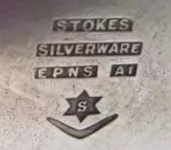
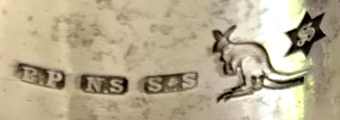
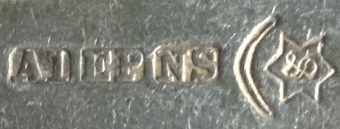

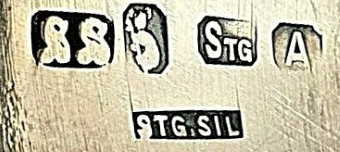

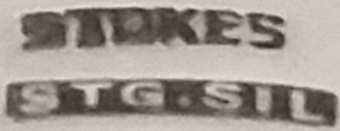
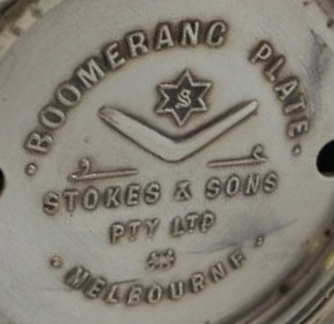
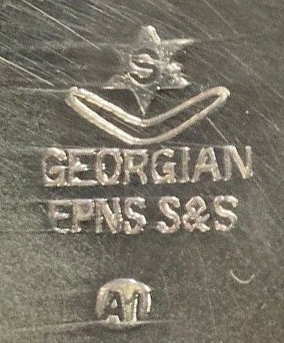

 |
Victoria, Melbourne Thomas Stokes was born in 1831 in Birmingham, England and migrated to Australia in the 1850s. After a partnership as Stokes & Martin, in 1893 he founded Stokes & Son at 29 Little Collins Street. The business was re-named in 1911 as Stokes & Son Pty Ltd (proprietary concern) engaging on mass-production of medals at competitive prices and, later, on a diversified production of sterling silver and silverplate wares. In 1935 the business moved to Albert Street, Brunswick, and in 1962 was renamed Stokes (Australasia) Pty Ltd (public company). By 2005, the business had relocated to the eastern suburb of Melbourne (Ringwood). 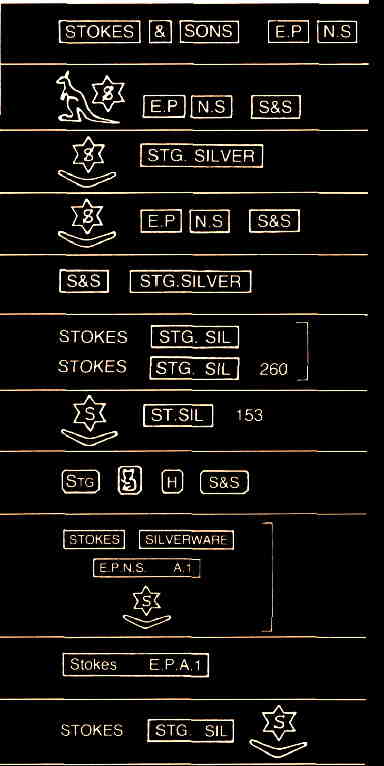 |
SUHARD & CO |
South Australia, Adelaide active c. 1900 |
TAYLOR & SHARP
 |
Tasmania, Hobart active c. 1900 |
TILBURY & LEWIS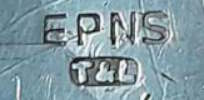

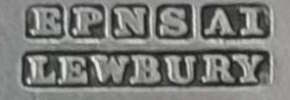 |
Victoria, Melbourne The history of Tilbury and Lewis has been traced to 1910, when Thomas W. Tilbury acquired the jewellery and watchmaking business of Henry Bennett, then trading at 290a Little Collins Street, Melbourne. In 1914 Thomas Tilbury entered in partnership with Norman Comper in Tilbury Manufacturing Company. The business was incorporated in 1916 as Tilbury, Comper and Company Pty Ltd. Comper left in 1918 and Thomas Tilbury was then joined by George Lewis, resulting in the formation of Tilbury and Lewis Pty Ltd at 165 Little Collins Street, Melbourne. The production of gold jewellery ceased around 1930 when Thomas Tilbury retired from the company. In the 1930s, under the control of George Lewis, Tilbury and Lewis Pty Ltd became one of the major manufacturers of electroplated nickel silver (EPNS) and sterling silverware in Australia. Trophies and plate with the mark LEWBURY were sold by many Australian retail jewellers and department stores (1930s-1980). |
|
HALLMARKS OF ENGLISH SILVER -
MAKER'S MARK IDENTIFICATION
|
| IMAGES | A& AC |
AD AK |
AL AZ |
B& BB |
BC BO |
BP BZ |
C& CA |
CB CC |
CD CF |
CG CL |
CM CS |
CT CZ |
D& DB |
DC DL |
DM DZ |
E& EA |
EB ED |
EE EH |
EI EO |
EP EZ |
F& FD |
FE FJ |
FK FZ |
G& GB |
GC GG |
GH GL |
GM GR |
GS GZ |
| IMAGES | H& H& |
HA HB |
HC HE |
HF HL |
HM HU |
HV HZ |
I& IG |
IH IL |
IM IZ |
J& JA |
JB JC |
JD JG |
JH JK |
JL JQ |
JR JR |
JS JS |
JT JZ |
KA KZ |
L& LB |
LC LZ |
M& MB |
MC MI |
MJ MZ |
N& NZ |
OA OZ |
P& PK |
PL PZ |
QA QZ |
| IMAGES | R& RB |
RC RG |
RH RK |
RL RQ |
RR RZ |
S& SB |
SC SI |
SJ SR |
SS SZ |
T& TC |
TD TG |
TH TN |
TO TS |
TT TZ |
UA UZ |
V& VZ |
W& WA |
WB WB |
WC WC |
WD WE |
WF WG |
WH WL |
WM WM |
WN WR |
WS WS |
WT XZ |
YA YZ |
ZA ZZ |
|
BRITISH TOWN MARKS AND DATE LETTERS
|
AUSTRALIA AND ITS SILVER
A BRIEF HISTORY
|
|
